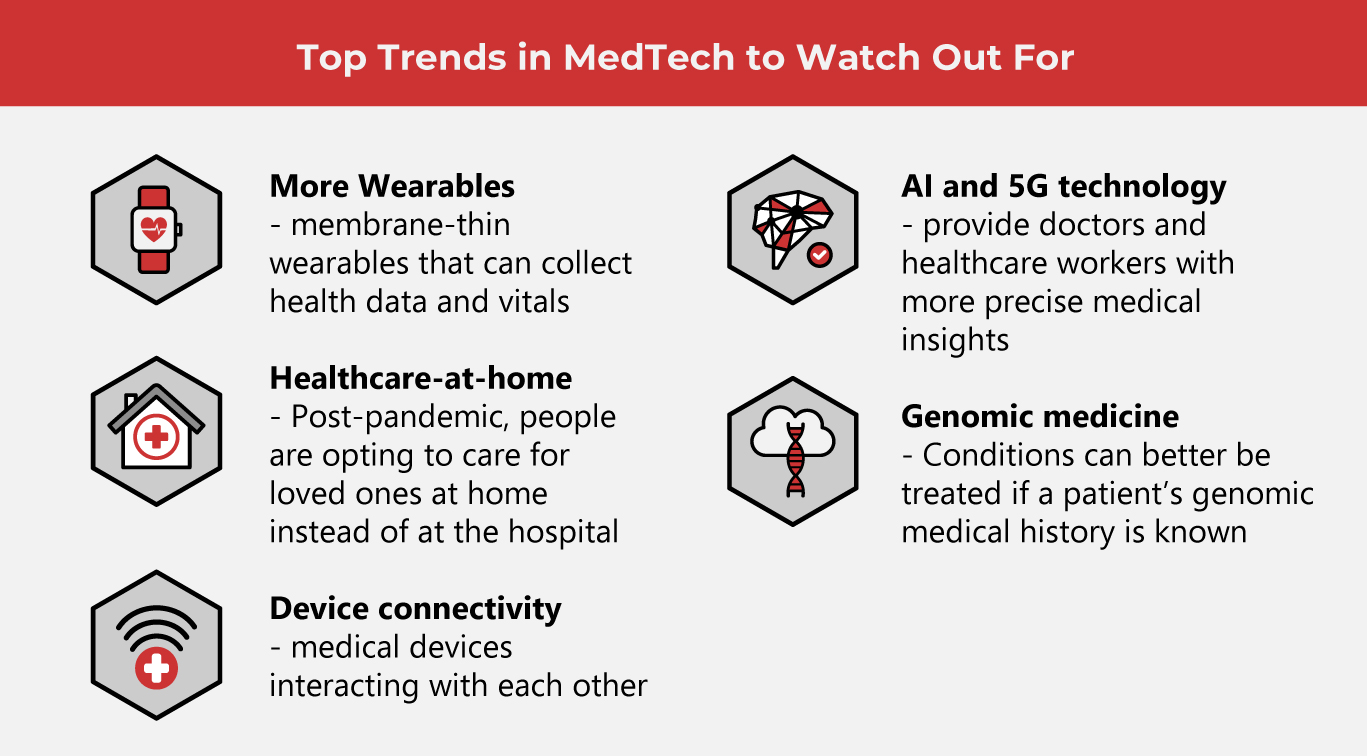It’s Medtech’s Time to Shine

The medical device industry and its larger umbrella industry MedTech are at the forefront of what’s driving healthcare and the medical field today. Here are a few trends we should be keeping an eye out for.
Experts in the healthcare sector say that life-saving devices and tech will continue to drive the Medtech industry this year and beyond. Wearables were a game changer when first introduced, and innovations making them thinner and more efficient are just the beginning.
The focus on gathering personal healthcare data per patient, and individualized and value-based health services ensure that each patient receives tailor-fit diagnosis and treatment for their specific conditions. Medical devices are vital to identifying, diagnosing, and treating illnesses. Better innovations improve a patient’s quality of life and even lengthen life expectancy.
The presence and prevalence of various chronic illnesses such as hypertension, diabetes, obesity, strokes, and arthritis to name a few, influence what innovations are made in medical devices. Our aging population is also a big factor. Senior citizens are more vulnerable to these chronic illnesses, and the more efficiently they can get diagnoses, the better their chances of getting proper treatment.
Market research shows us that this year, the market for medical devices will expand globally and that every seventy-three days in 2023, the amount of medical data collected will double.
(Also read: The Fight for the Future: Medical Technology and Outbreaks)

Wearables
Innovations around wearables will continue to drive medical devices forward. From smartwatches to membrane-thin wearables that can monitor and track one’s vitals such as blood pressure, pulse rate, and sugar levels, these devices make health data handier, oftentimes mitigating data gathering processes for quicker diagnosis and treatment of the patient. More advancements surrounding what wearables can do, and the data these can gather will drive further development.
Hospital-level care at home
Post-pandemic, many patients are opting to care for their loved ones at home rather than at the hospital for more personalized care, and in some cases, to keep costs down. Medical devices such as nebulizers, glucose monitors, and insulin delivery systems have become crucial to home set-ups. Many of these devices can also communicate with other devices such as mobile phones and other digital applications to transmit data gathered to the patient’s doctors.
Device Connectivity
Software as a medical device (SaMD) is used to enhance and improve medical device communication. These days, many medical apps are integrated into tablets, laptops, and mobile phones so that data is always available at the patient’s and their doctor’s fingertips. This information helps empower the patient into managing their healthcare programs and symptoms, allowing them a more proactive role in managing their conditions.
AI, Machine Learning, and 5G Technology
Artificial intelligence is used in fields of medicine such as oncology, cardiology, endocrinology, and gerontology. Machine learning helps doctors and healthcare professionals deepen their insights when it comes to better ways of treating their patients. 5G is integral to digital imaging and helps transmit clearer, crisper images from surgical microscopes for more efficient feedback from radiologists and other specialists.
The Power of Genes
Genomic medicine allows doctors to make sound decisions about a patient’s condition and treatment by looking into their genomic history and information. Advanced medical devices and technology can help delve into a patient’s genomic information for better, more individualized treatment.
3D-printed medical devices
3D printing or additive manufacturing is also a huge driver for MedTech. Prosthetics, modeling, and health aids can now be easily and conveniently manufactured today, as compared to just a few years ago. Rather than relying on larger manufacturing companies to create casts and prosthetic wear, with the help of 3D printing, custom-made pieces can be made much quicker and personally fit for every patient.
Robot-assisted healthcare
We’ve seen how robots are beneficial in hospital and healthcare environments, serving patients from senior citizens, to people with disabilities, to children. Robots are fast becoming indispensable tools for lifting, mobility, and carrying out repetitive tasks. Robots help address staff shortages in hospitals and clinics, adding an arm and a leg up for human healthcare workers.
Telemed is no longer a trend
In connection to home healthcare solutions, telemed sessions between a patient and their doctors need not physically take place at a clinic. Today, patients may consult with healthcare professionals from the comfort and convenience of any room inside their home, or even inside their vehicles. The presence and practicality of telemed sessions cut down on travel time for those unable to physically bring themselves to the clinic for a diagnosis.
As one of the Top 19 EMS companies in the world, IMI has over 40 years of experience in providing electronics manufacturing and technology solutions.
We are ready to support your business on a global scale.
Our proven technical expertise, worldwide reach, and vast experience in high-growth and emerging markets make us the ideal global manufacturing solutions partner.
Let's work together to build our future today.
Other Blog




